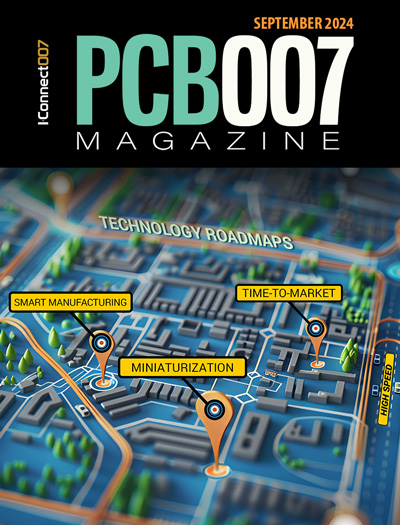-

- News
- Books
Featured Books
- pcb007 Magazine
Latest Issues
Current Issue
Engineering Economics
The real cost to manufacture a PCB encompasses everything that goes into making the product: the materials and other value-added supplies, machine and personnel costs, and most importantly, your quality. A hard look at real costs seems wholly appropriate.

Alternate Metallization Processes
Traditional electroless copper and electroless copper immersion gold have been primary PCB plating methods for decades. But alternative plating metals and processes have been introduced over the past few years as miniaturization and advanced packaging continue to develop.

Technology Roadmaps
In this issue of PCB007 Magazine, we discuss technology roadmaps and what they mean for our businesses, providing context to the all-important question: What is my company’s technology roadmap?
- Articles
- Columns
Search Console
- Links
- Media kit
||| MENU - pcb007 Magazine
RoBAT Brings TDR Test to Bare and Assembled PCBs
February 19, 2024 | Andy Shaughnessy, Design007 MagazineEstimated reading time: 4 minutes
When most people in this industry think of time domain reflectometry (TDR), they envision an electrical engineer running signal integrity simulation on a high-speed PCB during the design cycle. But RoBAT has flipped the script, migrating this SI functionality downstream with a range of automatic TDR testers for bare and assembled boards.
In an interview at DesignCon, Gregory Miczek, global applications manager with RoBAT, discussed the company’s background and its expansion path from backplane defect analyzers to TDR testers for high-tech bare and assembled boards.
Andy Shaughnessy: Gregory, tell us about RoBAT and how you all wound up moving TDR downstream from its usual spot in the development cycle.
Gregory Miczek: Sure. RoBAT started back in 2001 as a core test electronics company dedicated to the design and manufacture of automatic test equipment specifically for backplanes. We were doing shorts and continuity tests primarily on a proprietary machine, developed to test multiple signals by taking a robotic head and plugging into connectors on a board to tell whether they're connected in the right place, and that sort of thing.
We tested shorts and continuity for years, and we made our robotic manufacturing defect analyzers an industry standard and sold many machines around the world. But as technology in the backplane industry evolved, we saw speeds and data rates constantly increasing to the point that now shorts and continuities were no longer enough of a test.
So, we adapted our robotic test machine to add signal integrity test capability. We started by repackaging somebody else's TDR system into our system. We then went through a series of iterations to progressively reduce the cable length. With each iteration, there was a continuous improvement to the TDR resolution. We reached a point where the limiting factor was the existing TDR measurement systems on the market. So, we developed and tuned our own TDR unit packaged specifically for carrying the measurement unit around on our robotic head. The latest generation has the TDR measurement ports at the interface to our tooling to connect to the board under test. Now, our rise time and signal loss through our interface is as small as you can possibly get. We don't think we can actually get it any better. At that time, our machines had been designed to find faults created during the assembly process using TDR.
However, we soon realized the machine was not only finding assembly-related faults but also ones created in the fabrication of the bare board. In fact, it found more bare fab manufacturing faults than assembly-related faults. It was clear to us at this point that we should develop a version of the machine to test bare fabs. The goal was a machine that retained the ability to make multiple connections (up to x24) to the PCB in one insertion and, therefore, make it possible to test 100% of the high-speed nets in a production test environment. We have designed high-speed impedance-controlled compliant tips to contact the bare fab, which can be configured to match any pad/hole layout. At this point, because we've packaged it this way, we can also adapt this to any configuration of bare printed circuit board in the high-speed test realm. What we are primarily looking for are backdrill depth discrepancies, slivers, impedance variations and skew
Shaughnessy: This type of tester could work in the IC realm as well, right?
Miczek: Yes, correct, we have versions of the latest RoBAT Scara machines that will test assembled backplanes and line cards as well as bare fabs. We actually test all the way out to ASICs and FPGAs, and we're starting to find faults with ASICs on the customers’ line cards that they had no way to ever find before because they didn't even know these faults existed. I work with our customers closely, and now they're telling us what they're finding. It's really fascinating.
Shaughnessy: That’s great. Your customers are doing R&D for you because the tool has so many potential uses.
Miczek: That’s right. We've been blessed with a great core group of primary customers. We have historically sold primarily to contract manufacturers. However, we have some OEM customers who have heard about our equipment. One customer in Toronto bought our equipment just to test their own products, and they are having great success testing bare line cards measuring each signal from both ends. In a fully populated line card, we can't access the SMT end of the net, but testing prior to SMT installation, we can access the end of the net from the bare SMT pads, for example, on a BGA array. In the fully populated configuration, we make tooling to fit the size of the daughter card connector, for example, a 16-way version, each with a dedicated TDR measurement channel. This allows us to test every single signal from the connector side and tell you that the ASIC is now faulty from a TDR perspective.
Shaughnessy: This qualifies as a game-changer, I’d say.
Miczek: We think so.
Shaughnessy: Thanks for speaking with me, Gregory.
Miczek: Thank you, Andy.
Suggested Items
Skunk Works Demonstrates Airborne Battle Management of AI-Controlled Aircraft
11/27/2024 | Lockheed MartinLockheed Martin Skunk Works, in partnership with Lockheed Martin's Demonstrations and Prototypes organization and the University of Iowa's Operator Performance Laboratory (OPL), showcased a crewed-uncrewed teaming mission where an airborne battle manager issued real-time commands to AI-controlled aircraft through a touchscreen pilot vehicle interface (PVI).
NEOTech Significantly Improves Wire Bond Pull Test Process
11/25/2024 | NEOTechNEOTech, a leading provider of electronic manufacturing services (EMS), design engineering, and supply chain solutions in the high-tech industrial, medical device, and aerospace/defense markets, proudly announces a major advancement in its wire bond pull testing process, reducing manufacturing cycle time by more than 60% while maintaining industry-leading production yields of over 99.99%.
Real Time with... electronica 2024: SPEA's AI Integration—Innovations in Test Equipment
11/25/2024 | Real Time with... electronicaIn this interview from electronica 2024, Pete Starkey speaks with Andrea Furnari, VP of Electronic Test Products Business Unit for SPEA. The discussion revolves around AI integration in test equipment, trends in substrate materials, and SPEA's focus on R&D.
Winners of IPC Hand Soldering World Championship at electronica 2024 Announced
11/21/2024 | IPCIPC hosted its Hand Soldering World Championship in Munich, Germany, at electronica on 14-15 November 2024, welcoming 14 competitors from 13 companies and 12 countries worldwide. Skilled contestants competed to build an electronics assembly in accordance with IPC-A-610 Class 3 criteria, and were judged on the functionality of the assembly, compliance with the assembly process and overall product quality. The contestants were allowed a maximum of 60 minutes to complete the assembly.
Indie Semiconductor Extends Automotive Photonics Leadership with Advanced Optical Component Integration Capabilities
11/20/2024 | indie Semiconductorindie Semiconductor, an automotive solutions innovator, has extended its photonics offering with the addition of in-house photonics integration, packaging and system test capabilities.


